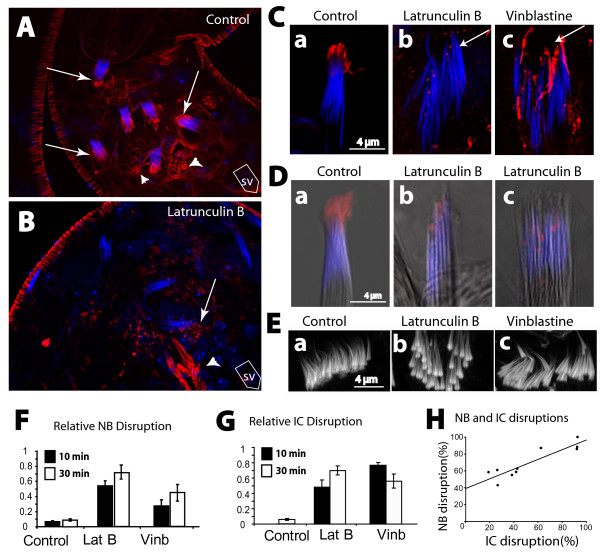Figure 6.
F-actin and microtubule maintain the actin cap, essential to maintain the maturing spermatids in a tight bundle. (A), (B) Wild-type testis stained with 4',6-diamidino-2-phenylindole (DAPI) (blue) and rhodamine isothiocyanate (RITC):phalloidin (red) after 30 minutes in PBS containing, (A) 8 μM DMSO (control), or, (B) 30 μM latrunculin B (lat B). Arrows indicate NBs of the mature sperm associated with the actin caps and arrowheads indicate residual caps left behind after sperm release. SV indicates the direction of the seminal vesicle. (C), (D) Isolated cysts stained with DAPI (blue) and RITC:phalloidin (red) after 30 minutes of incubation in PBS containing either, (a) 8 μM DMSO (control), (b) 30 μM lat B, or (c) 5 μM vinb as indicated at the top of the panels. Corresponding DIC images were overlaid in grey scale (D) to indicate the contours of the sperm heads. (E) F-actin cones of ICs from intact testis treated with (a) DMSO (control), (b) lat B and (c) vinb , respectively. (F), (G) Percentage NB (F) and IC (G) disruptions, after 10 (solid bars) and 30 (open bars) minutes of treatments presented as histograms with +S.E.M., and n > 6 for individual plots. (H) The points in the plot represent statistical correlations between the IC and the NB disruption indices within individual testes after 30 minutes of the lat B treatments. A straight line fitted through the points indicates the probability of a simultaneous occurrence of the two events together as estimated from the observed data (see Table 1 and associated legend for detail).

